Ever wondered what gives compression socks their superpowers? It’s not just about squeezing your legs. The real magic lies in the blend of materials that strike the perfect balance between comfort and performance. Whether you’re an athlete looking to enhance recovery or someone seeking day-long comfort, understanding what material are compression socks made of is key to unlocking their benefits.
In this article, we’ll unravel the mystery behind the materials for compression socks. Dive in to discover the surprising elements that contribute to peak performance and why choosing the right material matters more than you think.

Materials Used in Compression Socks
When it comes to compression socks, the material isn’t just about feel; it’s the core of their power. Dive into the fabric universe that elevates these socks from good to great.
- Cotton: Known for its natural comfort and breathability, cotton is a go-to for everyday wear. In the compression world, it’s blended with stretchier stuff for that just-right hug around your legs.
- Nylon: This synthetic wonder takes the spotlight with its strength, elasticity, and ability to keep you dry. Nylon ensures your socks stay snug, effective, and in shape, worn after wear.
- Wool: Far beyond sweater territory, wool’s knack for temperature regulation makes it a top pick for compression socks. It’s all about keeping your feet cozy or cool, plus it’s naturally anti-microbial.
- Merino Wool: Think of merino wool as wool’s luxurious cousin—softer, finer, and perfect for those with sensitive skin. It offers all of wool’s perks, with an extra dash of comfort.
- Elastic Materials (Spandex, Lycra): The unsung heroes of compression, Spandex, and Lycra, bring the stretch and snap needed for effective compression. They’re why these socks can boost circulation and reduce swelling with ease.
Each material has its own superpower, and the best compression socks mix and match these fabrics to give you comfort, durability, and the compression you need. Whether you’re chasing the moisture-wicking prowess of nylon, the natural coziness of cotton and wool, or the unbeatable elasticity of Spandex and Lycra, getting to know these materials is your first step toward finding your perfect pair of compression socks.
Rethinking Cotton: When It’s Not the Crown Jewel
Cotton, the fabric that feels like a soft embrace, often takes the throne in our wardrobes. But when it comes to compression socks, it’s time to pause and reconsider. Here’s why cotton might not always wear the crown in the kingdom of compression.
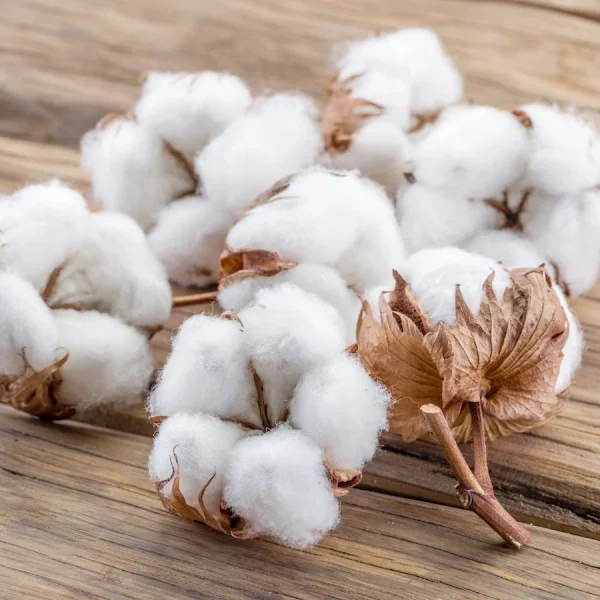
Source: https://www.masterclass.com/articles/what-is-cotton
Moisture Management
Cotton’s absorbency is a double-edged sword. Yes, it can soak up sweat, but then it holds onto it, leaving your feet feeling damp and uncomfortable. In contrast, materials like nylon excel at wicking moisture away, keeping your feet dry and happy.
Durability Under Pressure
Cotton is soft and comfortable, but when stretched, it doesn’t always bounce back like its synthetic counterparts. Over time, cotton compression socks might lose their snug fit, reducing their effectiveness in promoting circulation and preventing swelling.
Compression Consistency
The key to effective compression socks is their ability to apply consistent pressure. Cotton, being less elastic, struggles to maintain the necessary tension. Fabrics with higher elasticity, such as Spandex or Lycra, ensure that your socks deliver steady compression where you need it most.
Temperature Regulation
While cotton is breathable, it doesn’t offer the same temperature-regulating properties as wool or merino wool. These materials adjust to your body’s needs, keeping you warm in the cold and cool in the heat, making them a smarter choice for those seeking comfort in varying climates.
This isn’t to say cotton doesn’t have its place. Blended with other materials, it can contribute to the overall comfort and breathability of compression socks. However, for those seeking the peak performance of their gear, exploring beyond cotton can unveil a world of benefits tailored to your active lifestyle or daily comfort needs.

Cotton Fabric
Source: https://www.performancetextiles.org.uk/cotton-fabric/
The High-Performance Secrets of Nylon
In the realm of compression socks, nylon emerges as a champion, offering a suite of benefits that cater to the needs of the active and the everyday wearer alike. Let’s break down why nylon might just be your new best friend:

Nylon Fabric
Source: https://fabriclore.com/blogs/fabric-wiki/information-about-nylon-fabric
Strength and Elasticity
Nylon’s robust nature means your compression socks can withstand the rigors of daily wear and intense activities without losing shape or effectiveness. Its elasticity ensures a snug fit, adapting to your movements and providing consistent compression.
Moisture-Wicking Wizardry
Forget about sweaty discomfort. Nylon’s ability to wick moisture away from the skin keeps your feet dry, reducing the risk of blisters and ensuring comfort during long periods of wear.
Durability That Lasts
Nylon doesn’t just give up after a few washes. This material is built to last, maintaining its compressive properties and appearance over time, making it a cost-effective choice for those looking for long-term solutions.
A Closer Look at Comfort
While nylon might not have the natural softness of cotton, its smooth texture minimizes irritation, making it a solid choice for sensitive skin. Plus, its breathability adds to the overall comfort, keeping your feet cool and comfortable.
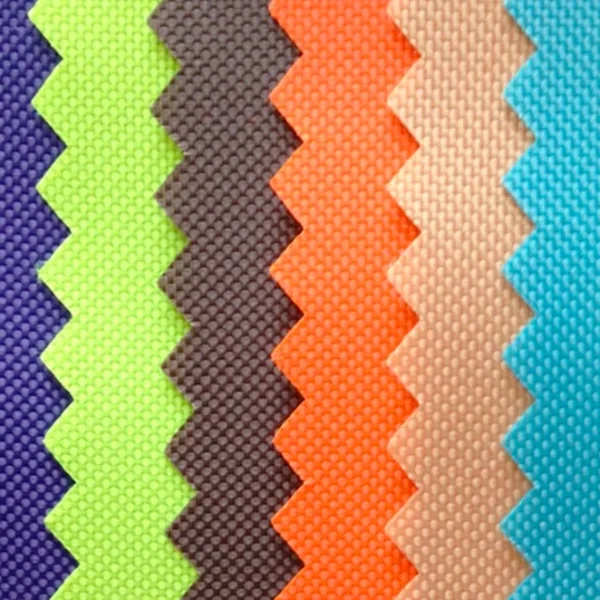
Nylon is a synthetic material made from polymers, which allows air to pass through its fibers.
Source: https://fabriclore.com/blogs/fabric-wiki/information-about-nylon-fabric
Versatility for Every Lifestyle
Whether you’re an athlete seeking performance support, a traveler looking to reduce leg fatigue, or someone who stands all day at work, nylon compression socks offer the versatility to meet a wide range of needs.
Nylon, with its blend of durability, comfort, and performance-enhancing properties, stands out as a material that truly supports your active lifestyle. By choosing nylon compression socks, you’re not just choosing a product that performs; you’re investing in a solution that elevates your daily comfort and well-being.
Wool and Merino: Nature’s Answer to Compression Comfort
Wool, especially its refined sibling Merino, brings a touch of nature’s genius to the compression sock game. Here’s a layered look at how these materials weave comfort and performance into every thread:

Wool
Source: https://greennettletextiles.com/nylon-breathable/
Natural Temperature Regulation
Wool’s most celebrated feature is its ability to regulate temperature. This means:
- Warm in Winter: Wool fibers trap air, creating a natural insulating layer that keeps your feet warm in colder climates.
- Cool in Summer: Surprisingly, these same fibers can wick away moisture, allowing your skin to breathe and keeping you cool when the mercury rises.
Moisture Mastery
Unlike cotton blend socks, wool efficiently manages moisture without feeling wet or clammy. Merino wool, in particular, excels at moving sweat away from the skin, ensuring your feet stay dry and comfortable, no matter the activity.
Softness and Strength
Merino wool is renowned for its softness, offering a luxurious feel without the itch associated with traditional wool. This softness, combined with wool’s natural durability, makes for a graduated compression sock that’s both comfortable and built to last.

Merino Wool
Source: https://blog.thejacketmaker.com/is-nylon-breathable/
Antimicrobial Properties
One of wool’s hidden talents is its natural resistance to bacteria and odors. This means your socks stay fresher for longer, making them ideal for extended wear or multi-day adventures.
Eco-Friendly Choice
For those conscious of their environmental footprint, wool, and merino wool are sustainable choices. They’re renewable, biodegradable, and require less frequent washing, reducing water usage and wear.
Wool and merino wool compression socks are more than just a cozy option for chilly days. They offer a unique blend of temperature regulation, moisture management, and natural comfort that stands up to the demands of both high-performance athletes and everyday wearers. With their added benefits of durability and eco-friendliness, these materials are a testament to the power of nature in enhancing our daily lives and activities.
Elastic Materials: The Core of Compression
At the heart of every compression sock lies its ability to apply pressure precisely where it’s needed. This is where elastic materials like Spandex and Lycra come into play, acting as the backbone of compression sleeves technology.
Here’s a detailed look at how these materials stretch beyond the ordinary to provide extraordinary benefits.

Unmatched Elasticity
- Snug Fit: Spandex and Lycra can stretch up to five times their original length, offering a snug, contoured fit that enhances blood circulation.
- Consistent Compression: They return to their original shape after stretching, ensuring consistent pressure distribution throughout the day.
Durability and Resistance
- Long-lasting Wear: These materials are resistant to oils, lotions, and sweat, making your knee-high compression socks more durable and less prone to wear and tear.
- Shape Retention: Even after multiple washes, Spandex and Lycra help your socks maintain their shape and compression level, providing lasting support.
Comfort and Flexibility
- Moves with You: The flexibility of Spandex and Lycra means your knee-high socks can move with your body, providing comfort without restricting movement.
- Smooth and Lightweight: These materials contribute to a lightweight, smooth fabric that feels comfortable against the skin, reducing the risk of irritation.
Versatile Support for All
Whether you’re an athlete looking for performance support, someone recovering from surgery, or just seeking everyday comfort, the inclusion of Spandex and Lycra in compression socks ensures they meet a wide range of needs. Their ability to provide targeted compression helps reduce swelling, prevent varicose veins, and improve blood flow, making them a versatile choice for anyone looking to improve their leg health.
Elastic materials like Spandex and Lycra are not just additives. They’re essential components that transform a regular sock into a compression powerhouse. By offering a perfect blend of comfort, durability, and targeted pressure, they ensure that your compression socks are not only effective but also a pleasure to wear throughout the day.
Choosing the Best Compression Socks
With a plethora of options at your fingertips, selecting firm compression socks can feel like navigating a labyrinth. Fear not! Here’s a straightforward guide to making an informed choice, ensuring your socks not only fit your lifestyle but also enhance it.
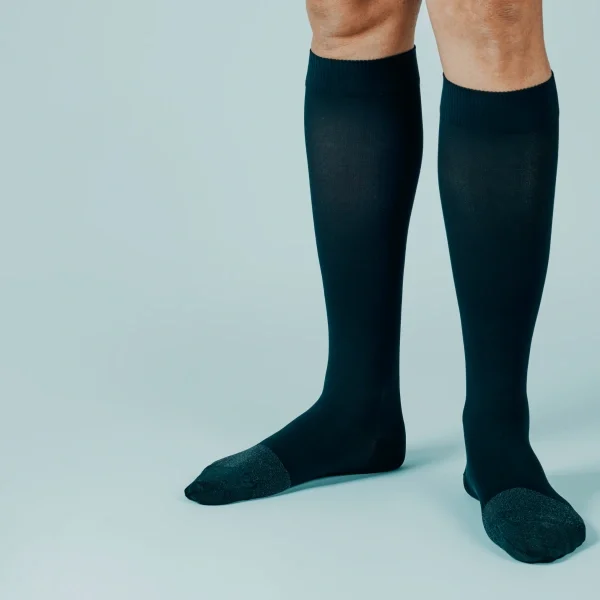
Assess Your Needs
- Activity Level: Are you a marathon runner, a nurse on your feet all day, or seeking comfort during travel? Your daily activities dictate the material blend that best suits your needs.
- Climate Considerations: Wool and Merino are champions in colder climates, while nylon and blends excel in warmer conditions for their moisture-wicking capabilities.
- Skin Sensitivities: For sensitive skin, look towards softer materials like merino wool or high-quality blends that offer comfort without irritation.
Material Matters
- For Athletes: Nylon and Spandex blends offer the elasticity and moisture-wicking properties needed for high-intensity activities.
- For Daily Comfort: Cotton socks can provide softness and breathability for everyday wear, enhanced with elastic materials for the necessary compression.
- For Medical Purposes: Consult with a healthcare provider to ensure the material and compression level meet your specific health requirements.
Quality Over Quantity
- Check Reviews: Look for feedback on durability, comfort, and effectiveness. High-quality materials might come at a premium but offer better longevity and performance.
- Brand Reputation: Established brands often invest in research and technology to provide superior compression socks that deliver on their promises.
Try Before You Buy More
- Sample Sizes: If possible, try on different sizes and materials to find the perfect fit and feel for your needs.
Choosing the best compression stockings isn’t just about picking a material. It’s about understanding how different fabrics cater to your specific needs, activities, and comfort levels.
Cotton vs. Nylon: The Ultimate Showdown
When it comes to compression stockings, the debate between cotton and nylon is as old as time. Each material boasts unique benefits, but how do they really stack up against each other? Let’s dive into the ultimate showdown to help you decide which champion deserves a spot in your drawer.

Comfort and Breathability
- Cotton: Reigns supreme in softness and natural breathability, making it a go-to for those with sensitive skin or who prefer a more natural feel.
- Nylon: Offers a sleek, smooth fit that excels in moisture-wicking, keeping feet dry and comfortable during intense activities or warm weather.
Durability and Maintenance
- Cotton: While cozy, cotton can lose its shape and compression effectiveness over time, especially with frequent washing and wearing compression socks.
- Nylon: Stands out for its resilience, maintaining both shape and compression level through rigorous use and wash cycles.
Performance and Fit
- Cotton: Tends to absorb moisture, which can lead to a heavier feel and potential discomfort during prolonged use.
- Nylon: Provides a consistent, snug fit that adapts to your movements, offering superior performance for athletes and active individuals.
Environmental Impact
- Cotton: Often praised for being a natural fiber, but its cultivation can be water-intensive and may involve pesticides unless it’s organic.
- Nylon: A synthetic option that’s durable and long-lasting, reducing the need for frequent replacements. However, its production involves petrochemicals, raising concerns about sustainability.
Making the Choice
When it comes to preventing blood clots, managing severe varicose veins, or simply enhancing daily comfort, the choice between cotton and nylon in compression socks becomes crucial. If you prioritize a natural feel and comfort, cotton might seem appealing. However, for those in need of moderate compression to support blood vessels and improve circulation, nylon’s durability, performance, and moisture management capabilities make it a standout choice.
Remember, the effectiveness of compression socks in preventing blood clots and aiding in managing severe varicose veins hinges on selecting the right compression stocking. Whether you opt for the softness of cotton or the resilience of synthetic fabric, ensuring you wear compression socks that offer the right balance of comfort, support, and moderate compression is key. Ultimately, the best compression sock is the one that meets your specific needs, helping your blood vessels function better, supporting your lifestyle, and enhancing your daily routine.
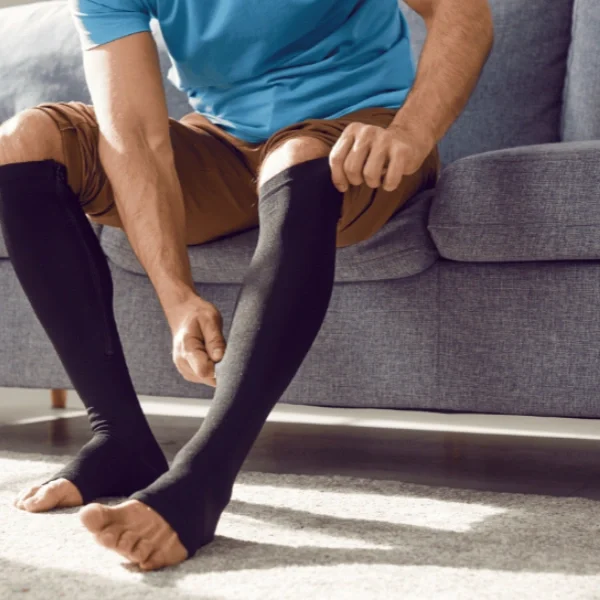
What’s the Right Tightness for Maximum Benefit
The key to unlocking the full potential of compression socks lies in finding the perfect tightness. It’s a delicate balance—too tight, and you’re uncomfortable; too loose, and you lose the benefits.
Here’s the lowdown:
- Measure Correctly: Ensure you’re measured for compression socks at the right time of day, ideally in the morning, to get the most accurate fit.
- Consult Professionals: A healthcare provider can recommend the ideal compression level based on your needs, whether it’s for athletic recovery, medical conditions, or daily comfort.
- Listen to Your Body: Comfort is crucial. If your socks are causing discomfort or pain, it’s a sign they might be too tight.
The right compression sock should feel like a firm, supportive hug around your legs—not too tight, but just enough to feel the benefits without any discomfort.
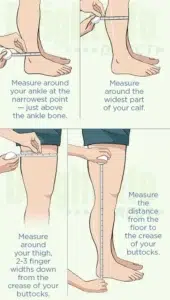
How to Measure for Compression Socks & Stockings.
Conclusion
Navigating the world of compression socks doesn’t have to be a maze. You’ve now got the map to make an informed choice, ensuring your next pair is a perfect blend of comfort, performance, and durability.
Here’s a quick recap of what we’ve uncovered:
- Nylon and Spandex blends are top picks for durability and moisture management.
- Cotton offers natural comfort, ideal for less intensive wear.
- Wool and merino wool excel in temperature regulation and natural softness.
- The right material depends on your specific needs, from daily comfort to athletic performance.
Choosing the right material for your compression socks is more than just a step towards better health; it’s a stride towards enhancing your daily life. Whether you’re running marathons, traveling the world, or just on your feet all day, the perfect pair of compression socks can make all the difference. Remember, it’s not just about the destination; it’s about enjoying the journey, one comfortable step at a time.
FAQs on Compression Sock Materials
1. What fabric is best for compression socks?
The best fabric for compression socks balances elasticity, comfort, and moisture management. Nylon and Spandex (or Lycra) blends are often considered ideal due to their durability, stretchability, and ability to wick away moisture, making them suitable for a wide range of activities and medical needs.
2. What are the best compression socks made of?
The highest quality compression socks are typically made from a blend of synthetic fibers like nylon or polyester for strength and moisture-wicking, combined with elastic materials such as Spandex or Lycra for stretch and compression. This combination ensures durability, effective compression, and comfort.
3. Are nylon or cotton compression socks better?
The choice between nylon socks and cotton compression socks depends on your specific needs:
- Nylon is better for activities requiring moisture management and durability, such as sports or long periods of wear.
- Cotton may be preferred for its natural softness and breathability, ideal for those with sensitive skin or for less intense, everyday wear. However, for effective compression and moisture control, nylon often outperforms cotton.
4. Do they make compression socks in cotton?
Yes, compression socks are available in cotton blends. These socks combine cotton’s natural softness and breathability with elastic materials to provide the necessary compression. While pure cotton compression socks are less common due to cotton’s limitations in elasticity and moisture control, cotton-blend compression socks offer a compromise between comfort and functionality.



